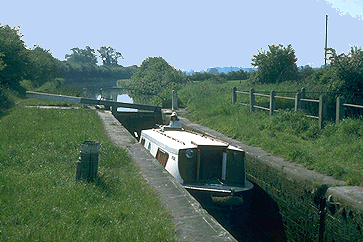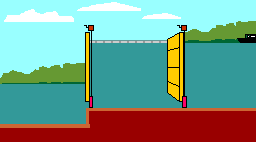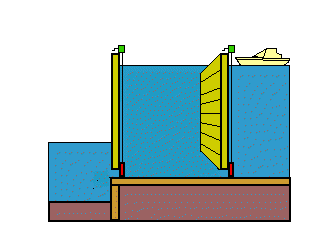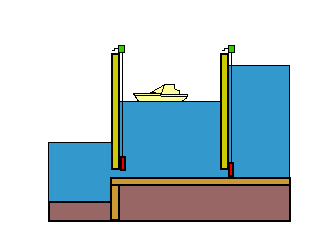 First, to orient you, a photo of an actual lock, with a boat about
half-way down in its descent.
First, to orient you, a photo of an actual lock, with a boat about
half-way down in its descent.


 First, to orient you, a photo of an actual lock, with a boat about
half-way down in its descent.
First, to orient you, a photo of an actual lock, with a boat about
half-way down in its descent.
 Dave [email protected]
has created a nice animation, at right, showing both a boat ascending
and a boat descending. This is described in more detail below.
Dave [email protected]
has created a nice animation, at right, showing both a boat ascending
and a boat descending. This is described in more detail below.
[Please note that the animation and the sketches below are both incorrect in two respects:
 Referring to the sketches at right (courtesy of Tel Monks),
visualize two bodies of water, one whose surface is, say, 8 feet above the other. Visualize
a "tank" (the lock) between the two bodies of water. The tank extends a few feet above the
higher water surface.
Now suppose we are cruising along in our boat on the upper body of water. Suppose also
that the water level in the tank is at the same level as we are. Then there is no problem in opening
the door (gate) on our side of the tank, and driving ourselves in.
Referring to the sketches at right (courtesy of Tel Monks),
visualize two bodies of water, one whose surface is, say, 8 feet above the other. Visualize
a "tank" (the lock) between the two bodies of water. The tank extends a few feet above the
higher water surface.
Now suppose we are cruising along in our boat on the upper body of water. Suppose also
that the water level in the tank is at the same level as we are. Then there is no problem in opening
the door (gate) on our side of the tank, and driving ourselves in.
 We close the door behind
us. We are now floating in the closed tank.
Now what? Well, using an interesting contrivance (a "paddle",
represented by the little red rectangles in the sketches), one of
our crew starts
to let water flow out of the tank into the lower body of water,
sort of like emptying a bathtub. As the water level in the tank goes down,
our boat naturally descends with it.
We close the door behind
us. We are now floating in the closed tank.
Now what? Well, using an interesting contrivance (a "paddle",
represented by the little red rectangles in the sketches), one of
our crew starts
to let water flow out of the tank into the lower body of water,
sort of like emptying a bathtub. As the water level in the tank goes down,
our boat naturally descends with it.
 When the tank is finally drained to the same level as the lower body of
water, we can open the door on that side (another "gate"), and steer our boat out.
When the tank is finally drained to the same level as the lower body of
water, we can open the door on that side (another "gate"), and steer our boat out.
For going up, we steer our boat into the drained lock, close the gate, allow water from the upper body of water to flow in. When the levels match, we open the upper gate and drive out.
A relative rarity on the canals is a set of "staircase locks." The upper gate of one lock is the lower gate of another. A lock is filled using water from the lock immediately above it; or, from the other point of view, a lock is drained into the lock immediately below it. These locks are ordinarily manned by lock-keepers, since everyone else gets hopelessly confused.
To state this another way:
The fun part occurs when you meet another boat in the staircase coming the other way ...
There once was a nice staircase lock interactive animation available on the web, but unfortunately, it has vanished. :-(
There are several 10-22 minute videos on youtube on staircase locks, it you are interested in learning more.
Another relative rarity on the canals are "side ponds" associated with locks. The side ponds allow a full lock cycle (from full to empty to full again) to be done WITHOUT using a whole lockfull of water. This seven minute video on Using Lock Side Ponds shows how this works.
[Photo: believe to be the second lock from the bottom of the Atherstone flight on the Coventry Canal.]
Read about how Joan and Pete Payzant first learned how to operate a lock.
Nigel Bromley has a detailed page on Canal Locks - collected thoughts on their theory
Very thorough coverage of locks, in all their variations, may be found on the Wikipedia page Lock (water transport).
Lockkeepers in France only require a very small tip for their services. They are well known to offer items for sale: home-made goat's cheese, eggs, fruit, and vegetables.
For an example of lock repair, see Photographs of Stenson Lock's bottom gates being replaced